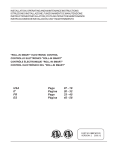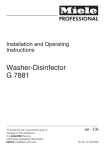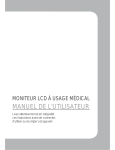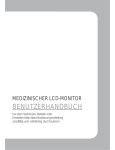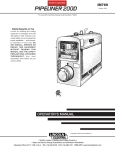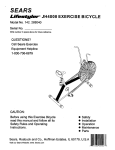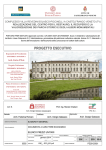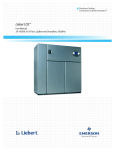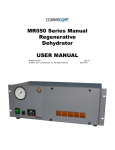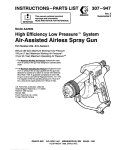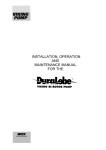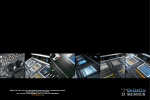Download Electrolux 5957 410 01 Refrigerator User Manual
Transcript
INSTALLATION, OPERATING AND MAINTENANCE INSTRUCTIONS ISTRUZIONI DI INSTALLAZIONE, FUNZIONAMENTO E MANUTENZIONE INSTRUCTIONS D'INSTALLATION, D'UTILISATION ET DE MAINTENANCE INSTRUCCIONES DE INSTALACIÓN, USO Y MANTENIMIENTO "PROSTORE SMART" VERTICAL REFRIGERATORS FRIGORIFERI VERTICALI "PROSTORE SMART" RÉFRIGÉRATEURS VERTICAUX "PROSTORE SMART" FRIGORÍFICOS VERTICALES "PROSTORE SMART" USA IT FR ES Page Pagina Page Página 07 20 33 46 -19 - 32 - 45 - 58 PART NO. 5957 410 01 VERSION 2 2005.12 INSTALLATION DIAGRAM SCHEMA DI INSTALLAZIONE SCHÉMA D'INSTALLATION DIAGRAMA DE INSTALACIÓN 105.66 Gallons / 400 Liters 105,66 Galloni / 400 litri 105,66 gallons / 400 litres 105,66 galones / 400 litros 23 5/8" 23 27/64" 2 3/4" 600 mm 595 mm 70 mm 12 51/64" 325 mm I 83 5/32" 2112 mm 7 7/8" 200 mm 2 7/8" 73 mm 53/64" 21 mm 17 7/8" 454 mm 2 7/8" 73 mm 2 13/64" 19 23/32" 4 1/4" 56 mm 501 mm 108 mm 23 5/8" 26 3/16" 600 mm 665 mm 53/64" K 21 mm I = electrical connection K = position of cables for fixing the appliance 1 37/64" 40 mm I = connessione elettrica K = posizione cordini per fissaggio apparecchiatura 47 1/4" I = branchement électrique K = position des câbles de fixation de l'appareil 1200 mm I = conexión eléctrica K = posición de los cables para inmovilizar el aparato 2 CONTROL PANEL PANNELLO COMANDI PANNEAU DE COMMANDE PANEL DE CONTROL 1 2a 3a 4 7 8 MANUAL DEFROST 9 COMPRESSOR STATUS POWER SUPPLY STATUS 1 2 3 CATEGORY 4 ACCESS TO FOOD CATEGORIES % SET HACCP HUM HIGH HIGH HUM. ON/OFF SERVICE ALARMS TEMPERATURE/ CATEGORY SELECTION HACCP ALARMS PRINT 2 7 DAYS REPORT 3 5 USA 1 2 2a 3 3a 4 5 6 7 8 9 10 - - 6 7 8 9 10 - 6 10 FR Access to Food Categories button High humidity ON/OFF button High humidity indicator light Service alarms button Service alarms indicator light Manual defrost / UP button Set temperature / Category selection / DOWN button HACCP alarms button Display Compressor status indicator light Power supply status indicator light Power ON/OFF button 1 2 2a 3 3a 4 5 6 7 8 9 10 IT 1 2 2a 3 3a 4 5 POWER ON/OFF - Bouton ACCESS TO FOOD CATEGORIES Bouton HIGH HUMIDITY ON/OFF Témoin lumineux HIGH HUMIDITY Bouton SERVICE ALARMS Témoin lumineux SERVICE ALARMS Bouton MANUAL DEFROST / UP Bouton temperature / Category selection / DOWN Bouton HACCP ALARMS Affichage Témoin lumineux COMPRESSOR STATUS Témoin lumineux POWER SUPPLY STATUS Bouton ON/OFF ES Accesso al pulsante per le categorie degli alimenti Pulsante ON/OFF elevata umidità Spia elevata umidità Pulsante allarmi di servizio Spia allarmi di servizio Pulsante superiore: sbrinamento manuale Pulsante inferiore: Impostazione temperatura / Selezione categoria Pulsante allarmi HACCP Display Spia stato compressore Spia stato alimentazione Pulsante ON/OFF 1 2 2a 3 3a 4 5 6 7 8 9 10 3 - Acceso al botón de categorías de alimento Botón High humidity ON/OFF Luz indicadora de alta humedad Botón de alarmas de servicio Luz indicadora de alarmas de servicio Botón Manual defrost / UP Botón Set / Category / DOWN Botón de alarmas HACCP Indicador Luz indicadora de estado del compresor Luz indicadora de estado del suministro eléctrico Botón de encendido/apagado ON/OFF REVERSING OPENING OF THE DOOR INVERSIONE APERTURA DELLE PORTE INVERSION DU SENS D'OUVERTURE DE LA PORTE CAMBIO DE DIRECCIÓN DE APERTURA DE LA PUERTA E F (Dett.1) G H (Dett.2) 4 LEVELLING THE APPLIANCE LIVELLAMENTO DELL'APPARECCHIATURA MISE À NIVEAU DE L'APPAREIL NIVELADO DEL APARATO +30 mm -10 mm 5 PRODUCT LOADING DIAGRAM SCHEMA DI RIEMPIMENTO DEL FRIGORIFERO DIAGRAMME DE CHARGEMENT DU PRODUIT DIAGRAMA DE CARGA DE PRODUCTO 6 USA TABLE OF CONTENTS SAFETY INSTRUCTIONS ......................................................... Page 9 A.1 GENERAL INFORMATION........................................................ Page 10 A.1.1 Foreword ..................................................................................................................... Page 10 A.1.2 Intended use and limitations ...................................................................................... Page 10 A.1.3 Testing ......................................................................................................................... Page 10 A.1.4 General safety rules .................................................................................................... Page 10 A.1.5 Customer’s responsibilities ....................................................................................... Page 10 A.1.6 Data plate position ...................................................................................................... Page 10 A.1.7 Physical safety features, hazards ............................................................................... Page 10 A.1.8 Immediate inspect for shipping damage ................................................................... Page 10 A.2 TECHNICAL DATA .................................................................... Page 10 A.2.1 Materials and fluids used ............................................................................................ Page 10 A.2.2 Dimensions, performance and consumption ............................................................ Page 10 B.1 INSTALLATION ......................................................................... Page 11 B.1.1 Removing the packaging ............................................................................................ Page 11 B.1.1.1 Removing the packaging and handling ...................................................................... Page 11 B.1.1.2 Disposing of the packaging ........................................................................................ Page 11 B.2.1 Positioning .................................................................................................................. Page 11 B.2.2 Electrical connection ................................................................................................... Page 12 B.2.3 Reversing opening of the door ................................................................................... Page 12 C.1 OPERATIONS and USER INSTRUCTIONS ............................. Page 13 C.1.1 Control panel ............................................................................................................... Page 13 C.1.2 Initial switch-on and temperature adjustment ............................................................ Page 13 C.1.3 Storage using catergories button ................................................................................ Page 14 C.1.4 “High humidity ON/OFF” button ................................................................................... Page 14 C.1.5 Loading the product .................................................................................................... Page 14 C.1.6 Defrosting .................................................................................................................... Page 15 C.1.7 Alarms ......................................................................................................................... Page 15 7 C.1.7.1 General description ..................................................................................................... Page 15 C.1.7.2 HACCP ........................................................................................................................ Page 15 C.1.7.3 Service alarms ............................................................................................................ Page 16 C.1.7.4 Service alarms list ....................................................................................................... Page 16 C.1.7.5 Alarm managing .......................................................................................................... Page 17 C.1.7.6 HACCP alarm reset ..................................................................................................... Page 17 C.1.7.7 Troubleshooting guide ................................................................................................ Page 17 D.1 ROUTINE MAINTENANCE ....................................................... Page 17 D.1.1 Cleaning the cabinet and accessories ....................................................................... Page 17 D.1.2 Precautions in the event of prolonged disuse ............................................................ Page 17 D.2 MAINTENANCE TO BE PERFORMED BY TRAINED PERSONNEL ONLY .................................................................. Page 18 D.2.1 Periodic cleaning of condenser .................................................................................. Page 18 D.2.2 Replacing the control panel bulb ................................................................................ Page 18 D.2.3 Replacing the power supply cable ............................................................................. Page 18 D.3 TROUBLESHOOTING .............................................................. Page 18 D.3.1 Quick troubleshooting guide ....................................................................................... Page 18 D.4 WASTE DISPOSAL AND DEMOLITION ................................... Page 19 D.4.1 Waste storage ............................................................................................................. Page 19 D.4.2 Procedure for preliminary dismantling of the appliance ............................................ Page 19 D.5 ENCLOSED DOCUMENTS ...................................................... Page 19 8 SAFETY INSTRUCTIONS To reduce the risk of fire, electrical shock, or injury when using your appliance, please follow these basic precautions including the following: • Read all instructions before using your appliance. • This Manual does not cover every possible condition and situation that may occur. Use common sense and caution when installing, operating and maintaining this appliance. • FOR YOUR SAFETY DO NOT STORE OR USE GASOLINE OR OTHER FLAMMABLE VAPORS AND LIQUIDS IN THE VICINITY OF THIS OR ANY OTHER APPLIANCE. • The installation of this unit must conform to local codes or, in the absence of local codes, to all National Codes governing plumbing, sanitation, safety and good trade practices. • BEFORE SERVICING, DISCONNET THE ELECTRICAL SERVICE AND PLACE A RED TAG AT THE DISCONNECT SWITCH TO INDICATE WORK IS BEING DONE ON THAT CIRCUIT. • NOTICE: CONTACT YOUR AUTHORIZED SERVICE COMPANY TO PERFORM MAINTENANCE AND REPAIRS. • NOTICE: Using any parts other than genuine factory manufactured parts relieves the manufacturer of all warranty and liability. • NOTICE: Manufacturer reserves the right to change specifications at any time without notice. • WARNING: The equipment warranty is not valid unless the appliance is installed, started and demonstrated under the supervision of a factory trained installer. • WARNING: The unit must be installed by Personnel who are qualified to work with electricity and plumbing. Improper installation can cause injury to personnel and/or damage to the equipment. The unit must be installed in accordance with applicable codes. SAVE THESE INSTRUCTIONS 9 A.1.7 PHYSICAL SAFETY FEATURES, HAZARDS The appliance has no sharp or projecting parts. DANGER! DO NOT REMOVE. There are guards on the units to prevent access to components which require air movement. A.1 GENERAL INFORMATION A.1.1 FOREWORD The purpose of this manual is to provide the necessary information for the correct installation, operation, use and maintenance of the appliance. Consequently, the manual and all the technical documentation enclosed with the appliance must be kept with the appliance at all times so that they can be consulted by the technician or end user. It is important to inform the appliance user about regulations concerning safety during and after installation. Read the instructions in the manual carefully before carrying out any operation whatsoever on the appliance, as they give important information about the standards and rules governing its installation and safe use. Improper installation, adjustment, alteration, service or maintenance can cause property damage, injury or death. Failure to observe the instructions in this manual when carrying out any operations on the appliance will relieve the manufacturer of all liability. Also, the manufacturer declines any responsibility in the event of problems caused by the use of non-original spare parts. No part of this of this manual may be reproduced. A 1.8 IMMEDIATE INSPECT FOR SHIPPING DAMAGE The container should be examined for damage before and during unloading. The freight carrier has assumed responsibility for its safe transit and delivery. If damaged equipment is received, either apparent or concealed, a claim must be made with the delivering carrier. Apparent damage or loss must be noted on the freight bill at the time of delivery. The freight bill must then be signed by the carrier representative (Driver). If the bill is not signed, the carrier may refuse the claim. The supplier can supply the necessary forms. A request for inspection must be made to the carrier within 15 days if there is concealed damage or loss that is not apparent until after the equipment is uncrated. The carrier should arrange an inspection. Be certain to hold all contents plus all packing material. Under no circumstances should a damaged appliance be returned to the manufacturer without prior notice and written authorization. A.2 TECHNICAL DATA A.1.2 INTENDED USE AND LIMITATIONS This appliance has been designed for the refrigeration and preservation of foodstuffs. Any other use is to be considered improper. ATTENTION: these appliances are not suitable for installation outdoors and/or in environments subject to natural elements (rain, direct sunlight, etc.). The manufacturer declines all liability for any improper use of the product. A.2.1 MATERIALS AND FLUIDS USED All areas designed to come into contact with food are in steel or covered in non-toxic plastic material. An HFC refrigerant, in compliance with current legal standards, is used in the refrigerating units. The type of refrigerant gas used is stated on the data plate. A.2.2 DIMENSIONS, PERFORMANCE AND CONSUMPTION A.1.3 TESTING Our appliances have been designed and optimised with laboratory testing to give high performance and efficiency. The product has gone through 100% testing and is ready for use. The certificates guaranteeing that the tests (visual inspection electrical test - functional test) have been passed are included with the appliance and are included in specific enclosures. (section D.5). Gross capacity External dimensions: - Width - Depth with door closed - Depth with door open - Height A.1.4 GENERAL SAFETY RULES The appliance is manufactured in compliance with following directives: - Hygiene: ANSI / NSF 7 - Safety: UL 471 - CAN / CSA C22.2 No.120 - M91 400 Iiters 23.62” 26.18” 47.24” 83.15” 600mm 665mm 1200mm 2112mm Chamber dimensions: - Width 21.26” - Depth 21.65” - Height 58.42” Shelf dimensions 20.87”x15.75” 540mm 550mm 1484mm 530x400mm - VERSIONS WITH POWER SUPPLY VOLTAGE 120V/1ph/60Hz Internal temp. range 35.6°F/50°F +2°C/+10°C Max. ambient temp. +109.4°F +43°C Current input (°) 5A Refrigerant charge R134a 0.617lbs 280 gr Refrigerant capacity (R134a) (¹) 260 W Refrigerant capacity (R134a) (²) 556 W No. and type of defrostings (*) max each 18h x max 30‘ For model PR43RE1FEU. A.1.5 CUSTOMER’S RESPONSIBILITIES A fused disconnect switch or a main circuit breaker (customer furnished) MUST be installed in the electric supply line for the appliance. It is recommended that this switch/circuit breaker have lockout/tagout capability. Before making any electrical connections to this appliance, check that the power supply is adequate for the voltage, amperage, and phase requirements on the rating plate. The customer also must provide a grounded electrical line cord of suitable capacity for the input specified on the data plate. A.1.6 DATA PLATE POSITION The data plate with all the appliance specifications is located on the refrigeration unit compartment at the top right hand side. There is also a plate bearing the appliance’s PNC code and serial number located underneath the logo. 105.67gal. (°) At room temperature 104°F/40°C. (¹) At room temperature +95°F/+35°C, condensation temperature 131°F/+55°C and evaporation temperature 14°F/-10°C. (²) ASHRAE PERFORMANCE ambient temperature 89.6°F/ +32°C, condensation temperature 129.92°F/+54.4°C and evaporation temperature 44.96°F/+7.2°C. (*) Auto (by electronic board) 10 B.1 INSTALLATION pressed board: protective surround elements WEAR PROTECTIVE GLOVES WHEN UNPACKING AND INSTALLING THE APPLIANCE. B.2.1 POSITIONING Install the equipment, taking all the safety precautions required for this type of operation, also respecting the relevant fire-prevention instructions. Place the appliance in a ventilated room and away from heat sources such as radiators or airconditioning systems, in order to allow the cooling of the refrigerating unit components. Never cover the condenser, not even temporarily, as this may jeopardise the operation of both the condenser and the appliance. Make sure to position the appliance taking into consideration the space needed for door opening. Pay particular attention to levelling of the floor on which the appliance stands, in order to ensure its optimal operation. Read these instructions carefully before attempting installation. Installation and initial startup should be performed by a qualified installer. Unless the installation instructions for this product are followed by a qualified service technician (a person experienced in and knowledgable with the installation of commercial equipment) then the terms and conditions on the Manufacturer's Warranty will be rendered void and no warranty of any kind shall apply. IF IN DOUBT PLEASE CONTACT LOCAL SERVICE AGENCY. IMPORTANT: CAUTION: level the appliance, otherwise its operation could be compromised. the operations described below should be carried out in compliance with current safety regulations, with reference both to the equipment used and the operating procedures. Use the height-adjustable feet to make sure the appliance is level, and at the same time check that the door closes properly. IMPORTANT: before moving the appliance, make sure that the load-bearing capacity of the lifting equipment to be used is suitable for the weight of the appliance. B.1.1 REMOVING THE PACKAGING B.1.1.1 Removing the packaging and handling Cut the straps and remove the protective film, taking care not to scratch the sheet metal if scissors or blades are used. Remove the top (in cardboard), the polystyrene corners and the vertical protection pieces. For appliances with stainless-steel cabinets, carefully remove the protective film without tearing it, to avoid leaving glue stuck to the surface. Should this happen, remove the traces of glue with a noncorrosive solvent, rinsing it off and drying carefully. It is advisable to go over all the s/steel surfaces with a rag soaked in vaseline oil, in order to form a protective film. Use a transpallet or forklift truck to lift appliances. Inserting the forks under the pallet, lift the appliance and carry it to the place of installation, making sure that the load is balanced. +30 mm -10 mm WARNING: during handling do not push or pull the unit: it may tip over or be damaged. For trouble-free operation of the appliance, it is recommended that a gap of at least 9.84”/ 250mm be left between the appliance and the ceiling. Should the appliance be installed in rooms where there are corrosive substances (chlorine, etc.), it is advisable to go over all the stainless steel surfaces with a cloth coated with vaseline oil, in order to form a protective film. The maximum ambient temperature at which the appliances may operate is +109.4°F/+43°C. B.1.1.2 Disposing of the packaging Packing materials should be disposed of accordance with the binding laws in the country where the appliance is to be used. Recyclable plastic parts are marked as follows: polythene: outer wrapping, instructions booklet bag PE Note: the power plug should be accessible even after having placed the appliance in its final position for installation. IMPORTANT: on the back of the appliance there are two cables, indicated with the letter “K”. These cables are used for fixing the appliance to the wall, if required. polypropylene: straps PP polystyrene foam: corner pads PS 11 53/64" 21 mm K B.2.3 REVERSING OPENING OF THE DOOR These cabinets are normally supplied with opening to the right. When changing direction of opening so that the door opens from left to right, proceed as follows: • disconnect from the power supply; • remove lower bracket “H” (Detail 2); • remove the door and remove component “G” (Detail 2); • unscrew the two fixing bolts from bracket “E” and the screw which secures hinge “F” (Detail 1); • turn the door and fit component “G” and hinge “F” on the opposite side; • fix upper hinge “E” on the left hand side of the cabinet; • refit lower bracket “H” on the opposite side of the cabinet; • fit the door onto lower hinge “H”; • fix bracket “E” to the structure by screwing down the fixing bolts; • reconnect the power supply. 53/64" 21 mm 1 37/64" 40 mm E F B.2.2 ELECTRICAL CONNECTION When making the electrical connection, carefully comply with the information on the dataplate. The appliance works on 120V/1ph/60Hz. (Dett.1) CAUTION: Connection to the electrical mains must be carried out in accordance with current regulations and the standards required by the National Electric Code (NEC), known as NFPA 70. Please check: Connection to the main power must be carried out in accordance with binding rules and standards. Before connecting, make sure that: - The line cord has an efficient grounding connection and the main power frequency corresponds to that stated on the data plate. If you have doubts on the efficiency of the grounding connection have the circuit checked by a qualified technician. - The appliance must be connected to the main power with a permanent connection. - In order to protect the appliance from possible overloads or short-circuits, a fused disconnect switch or a main circuit breaker (customer furnished) MUST be installed in the electric supply line for the appliance. It is recommended that this switch/circuit breaker have lockout/tagout capability. Before making any electrical connections to this appliance, check that the power supply is adequate for the voltage, amperage, and phase requirements on the rating plate. The customer also must provide a grounded electrical line cord of suitable capacity for the input specified on the data plate. - After making the connection and with the appliance running, check that the rated level does not fluctuate by ± 10%. G H (Dett.2) The connection must be made with cable of a suitable for amperage and voltage. The manufacturer will accept no liability for any damage or injury resulting from the violation of the above rules or of the current electrical safety standards in the country where the appliance is used. 12 the Unit of Measure Indicator light starts flashing. C.1 OPERATIONS and USER INSTRUCTIONS - To change the SET temperature, press SET/DOWN button or MANUAL DEFROST/UP button within 15 seconds C.1.1 CONTROL PANEL 2a 3a 4 1 7 8 MANUAL DEFROST 9 COMPRESSOR STATUS SET POWER SUPPLY STATUS 1 2 3 CATEGORY 4 ACCESS TO FOOD CATEGORIES % SET HACCP HUM HIGH HIGH HUM. ON/OFF SERVICE ALARMS TEMPERATURE/ CATEGORY SELECTION 1 2 2a 3 3a 4 5 6 7 8 9 10 - 3 POWER ON/OFF or 7 DAYS REPORT PRINT 2 HACCP ALARMS 5 6 10 Access to Food Categories button High humidity ON/OFF button High humidity indicator light Service alarms button Service alarms indicator light Manual defrost / UP button Set temperature / Category selection / DOWN button HACCP alarms button Display Compressor status indicator light Power supply status indicator light Power ON/OFF button - To store the new set value, wait until it stops flashing to exit the program C.1.2 INITIAL SWITCH-ON AND TEMPERATURE ADJUSTMENT The appliance features an ON/OFF switch for activating the appliance. SET Turn on the appliance by pressing the ON/OFF button: if a selection is not made after 15 seconds, the last value displayed will be confirmed automatically and the chamber temperature display is restored. Example of setting: - switch on the appliance To set the chamber temperature, follow these steps: - press and hold SET/DOWN button for 5 seconds, SET - confirm the set temperature SET the SET POINT value appears on the display 13 if “NONE” is displayed, this means that the function is disabled. To select the category, press MANUAL DEFROST/UP or SET/ DOWN button - press SET/DOWN button or MANUAL DEFROST/UP button temperature SET or or SET - To store the new set value, wait until it stops flashing to exit the program once selected, if a selection is not made after 5 seconds, the last category displayed will be confirmed automatically and stored. SET C.1.4 "HIGH HUMIDITY ON/OFF" BUTTON "HIGH HUMIDITY ON/OFF" button can be pressed to make the appliance operate with a high humidity level. An indicator light comes on when the high humidity function is selected. With button pressed (High RU %): Here below the temperature range for the appliances: Position “MIN” = Position “MAX” = % HUM HIGH - average humidity reading with ambient temperature 109.4°F/ +43°C, chamber temperature 35.6°F/+2°C: 32°F / 0°C +50°F / +10°C R.H. = ~ 80% C.1.3 STORAGE USING CATEGORIES BUTTON By selecting the “CATEGORY” of food to be preserved, the appliance creates the right balance between temperature and humidity in the chamber for optimum preservation of the particular product stored. With button released (Low RU %): - average humidity reading with ambient temperature 109.4°F/ +43°C, chamber temperature 35.6°F/+2°C: R.H. = ~ 66% There are 4 pre-set categories: CATEGORY n. 1 red meat CATEGORY n. 2 cheese and meat dishes CATEGORY n. 3 fruit and vegetables CATEGORY n. 4 drinks. C.1.5 LOADING THE PRODUCT Food must be evenly distributed inside the chamber (away from the door and back wall) in order to allow proper circulation of air. Keeping button pressed down will display the selected category; 2 1 2 3 CATEGORY 4 14 you get information on maximum temperature, time and date (day, month and year) alarm occured. There is a sticker inside the chamber indicating the maximum level of loading: There are two possible situations: a) the alarm is running b) the alarm has occured a) the alarm is running Cover or wrap food before placing it in the refrigerator and avoid putting hot foods or steaming liquids inside. Do not leave the door open longer than necessary when putting in or taking out products. It is advisable to keep the keys in a place accesible only to authorized personnel. In order to avoid the use of the appliance by non-authorized people, it is advisable to lock it. 77˚/25˚ Temperature ˚F/˚C 68˚/20˚ 59˚/15˚ 50˚/10˚ Critical temperature 41˚/5˚ C.1.6 DEFROSTING - Automatic defrosting The appliance is equipped with an automatic defrost function. This function is indicated by the “dEFr” indicator light. Defrost water is routed to a bowl, from where it evaporates automatically. 17:05 HOW TO CHECK IT? display: rolling label i.e. “TEMP 78.8F / 26C” - Manual defrosting The defrost cycle can be activated manually by pressing the MANUAL DEFROST/UP button for 5 seconds buzzer: ON sound alarm WHAT IS RECORDED? HACCP Press : the buzzer is going OFF; then press again for 5 seconds and the alarm is showed (AL1). HACCP Press again: temperature, starting time and During this function the “dEFr” indicator light stays on. date are shown by a rolling label: “TEMP 78.8F/26C Start 17.05 10-10-99 End----”. C.1.7 ALARMS C.1.7.1 General description We have available in the electronic board 2 type of alarm system: a) the alarm has occured - the HACCP - the SERVICE ALARMS 77˚/25˚ Temperature ˚F/˚C 68˚/20˚ The HACCP stores and manages the MAXIMUM CHAMBER HIGH TEMPERATURE ALARMS. 59˚/15˚ 50˚/10˚ Critical temperature time 41˚/5˚ The SERVICE ALARMS stores and manages all the alarms available in the electronic board (except the “chamber high temperature” alarm). 16:00 17:00 18:00 19:00 20:00 21:00 22:00 HOW TO CHECK IT? C.1.7.2 HACCP HACCP · ALARM CONDITIONS - the display shows an alarm by the label “TEMP” - pushing display: is showing the label “TEMP” buzzer: ON sound alarm WHAT IS RECORDED? HACCP Press HACCP : the buzzer is going OFF; then press again for 5 seconds and the alarm is showed (AL1). HACCP Press 15 again: maximum temperature inside, · HOW LONG ARE THE ALARMS RECORDED? Until you have seen the complete alarms list recorded. After that, they will remain stored ‘till a new alarm occurs: the reset will be automatic. starting and ending time and date of the alarm are shown by a rolling label: “TEMP 78.8F/26C Start 17.05 10-10-99 End----”. To have access to recorded HACCP alarms press · HOW TO FIND AN ALARM? - blinking led of alarm button - buzzer ON (sound alarm) HACCP button for 4 seconds; now the display visualizes HISt and then AL_1 (symbol of the alarm); this shows the last maximum chamber temperature alarm stored in the PCB. · HOW TO CHECK THE ALARMS? HACCP Press Keep pressed the button button to visualize the value of last the last alarm (a label) occured and the buzzer is going OFF. In maximum chamber temperature alarm. Now in the display we visualize: - TEMP 78.8F/26C (type and value of maximum chamber temperature alarm) - Start time and date (starting date and time of alarm) - End time and date (ending date and time of alarm) order to reset the alarm, press C.1.7.4 SERVICE ALARMS LIST · Type “b” service alarms button to return to visualize the symbol of HACCP the alarm (AL1). Press until the display shows “----”. HACCP Press : the display is showing button to visualize the b1 Door is open Microswitch is broken b2 Reset HACCP memory next maximum chamber temperature alarm. If nothing is pressed within 10 seconds we go out from HACCP section. b3 · HOW TO CHECK THE OLD ALARMS? b4 The condenser is dirty Condenser fan is broken Missing supply Wrong plug positioning HACCP Keep pressed the button : the display shows · Type “E” service alarms AL1 (the last alarm); to select all the other alarms (AL2, AL3, ...) press . · HOW LONG ARE THE ALARMS RECORDED? Forever, or better, until the memory is out of space (maximum number of recorded alarms: 99). C.1.7.3 SERVICE ALARMS To have access to SERVICE ALARMS press button for 4 seconds; now the display visualizes the first SERVICE ALARM stored in the electronic board, for example “b1” (door open). Press the button to visualize the next SERVICE ALARM stored in the electronic board. If the electronic board has not stored other SERVICE ALARMS, the display visualizes “----”. If nothing is pressed within 5 seconds we go out from SERVICE ALARMS. 16 E1 Sensor short-circuited E2 Sensor is broken or disconnected E3 Sensor short-circuited E4 Sensor is broken or disconnected E5 Sensor short-circuited E6 Sensor is broken or disconnected E7 Sensor short-circuited E8 Sensor is broken or disconnected E9 Low chamber temperature E10 Low evaporator temperature C.1.7.5 ALARM MANAGING · Whenever a high chamber temperature alarm occurs the display shows the label “TEMP” and the buzzer is active. D.1 ROUTINE MAINTENANCE Routine maintenance tasks can be performed by non-specialised personnel. When performing maintenance please follow the instructions closely, keeping safe at all times. The manufacturer declines any responsibility for injury sustained from unsafe acts. HACCP · To reset the buzzer press the button for 1 second. · Whenever a type “b” service alarm occurs the display shows the label code of the alarm and the buzzer is active. · Whenever a type “E” service alarm occurs the display shows the label code of the alarm and the buzzer is active. IT IS NECESSARY TO CONTACT THE TECHNICAL ASSISTANCE. · To reset the buzzer press the ATTENTION: do not touch the appliance if hands and/or feet are wet. Before performing any cleaning or maintenance disconnect the appliance from the electrical source and carefully unplug the appliance. It is DANGEROUS AND UNADVISEABLE to remove the safety guards, AND IS NOT REQUIRED for routine maintenance. Wear protective gloves when cleaning the condenser. Do not use scissors, screwdrivers and sharp objects on the cooling circuit. button for 1 second. D.1.1 CLEANING THE CABINET AND ACCESSORIES Before using the unit, clean all the internal parts and accessories with warm water and either neutral soap or products that are over 90% biodegradable (in order to reduce the emission of pollutants into the environment), then rinse and dry thoroughly. Do not use solvent-based detergents (e.g. trichloro-ethylene) or abrasive powders for cleaning. Coat the metal panels with protective vaseline oil. It is advisable to clean the chamber every week, increasing this frequency according to appliance use. C.1.7.6 HACCP ALARM RESET The maximum number of high chamber temperature recording alarms is 99. Whenever the memory is full and a “b2” alarm occurs or at the end of the year, it is necessary to reset the memory in the following way: HACCP button until the label “HiSt” will · press the appear; · keep pressed together RES SET D.1.2 PRECAUTIONS IN THE EVENT OF PROLONGED DISUSE If the appliance is not going to be used for a long period, take the following precautions : • switch the appliance off using the ON/OFF button; • disconnect the circuit-breaker installed upline of the appliance; • remove all food from the chamber and clean the interior and the accessories; • leave the door ajar so that air can circulate inside the chamber, preventing the formation of unpleasant odors and mold; • rub all the stainless steel surfaces vigorously with a cloth slightly dampened with vaseline oil, so as to cover them with a protective film; • make sure that the premises is aired regularly. HACCP until the display shows “RES”. C.1.7.7 TROUBLESHOOTING GUIDE (problems which can be solved immediately) LABEL b1 b2 b3 PROBLEM ACTION The door is open or m icroswitch is broken HACCP mem ory is full High temperature of condens er Check the door, if it's ok, contact technical assistance center Power b4 failure Reset HACCP mem ory Check the condenser, if it's cleaned or uncovered, contact technical ass istance center Check the power s upply, if it's ok, contact technical ass istance center 17 D.3 TROUBLESHOOTING D.2 MAINTENANCE TO BE PERFORMED BY TRAINED PERSONNEL ONLY D.3.1 QUICK TROUBLESHOOTING GUIDE In some cases faults can be remedied easily and quickly. Below there is a list of possible faults and remedies: Non-routine maintenance tasks must be performed by an AUTHORIZED SERVICE AGENT. A. The appliance doesn’t switch on: - check that the power plug is properly inserted into the socket. - check that the mains socket is powered. B. The internal temperature is too high: - check the thermostat setting; - check there is no heat source near the appliance; - check that the door closes properly. - check that the appliance is loaded correctly. C. The appliance is excessively noisy: - check that the appliance is standing level. An unbalanced position can set off vibrations. - check that the appliance is not touching other appliances or parts which could reverberate; USE APPROPRIATE SAFETY GEAR (GLOVES AND MASK) WHEN CARRYING OUT ANY MAINTENANCE OPERATION. ATTENTION: do not touch the appliance if hands and/or feet are wet. Before performing any cleaning or maintenance disconnect the appliance from the electrical source and carefully unplug the appliance. Do not remove safety guards. Wear protective gloves when cleaning the condenser. Do not use scissors, screwdrivers and sharp objects on the cooling circuit. D.2.1 PERIODIC CLEANING OF CONDENSER Periodic cleaning of the condenser unit depends on the frequency of use of the appliance. The condenser must be cleaned periodically to ensure the efficient operation of the appliance and its continued high performance over time. It is DANGEROUS AND UNADVISEABLE to remove the safety guards. It is advisable to thoroughly clean the condenser slits of the refrigerating unit at least once a month in a dusty environment or once every three months in a closed and clean environment. The condenser can be cleaned with a brush, provided the bristles are not made of steel or a material that can compromise good operation, or a vacuum cleaner to remove the dirt. Take maximum care not to bend the condenser fins, as this would cause a reduction in the heat exchange. Do not use pointed objects, as they may damage the condenser. If the defect persists after having carried out the above checks, contact the service center, remembering to give the following details: • the nature of the fault; • the appliance’s PNC (production number code); • the Ser. No. (appliance serial number). Note: The data plate with all the appliance specifications is located on the refrigeration unit compartment at the top right hand side. There is also a plate bearing the appliance’s PNC code and serial number located underneath the logo. These are essential for identifying the type of appliance and date of manufacture. PNC 726673 Ser.No.61200050 ATTENTION: the condenser is installed on the top of the appliance. Do not clean the appliance with jets of water. D.2.2 REPLACING THE CONTROL PANEL BULB To replace the bulb under the control panel, proceed as follows: • disconnect from the power supply; • remove the bulb protective cover, which is secured with a self-tapping screw; • replace the bulb with one of the same wattage or equal to that indicated on the rating plate; • refit the protective cover; • reconnect to the power supply. Example: PNC 726673 - Ser.No. 61200050 726673: Prostore Smart 61200050: manufactured in 2006, week 12, 50th item. D.2.3 REPLACING THE POWER SUPPLY CABLE To replace the power supply cable proceed as follows: • disconnect from the power supply; • remove the electrical wiring protective cover; • replace the power supply cable; • refit the protective cover; • reconnect to the power supply. 18 D.4 WASTE DISPOSAL AND DEMOLITION D.4.1 WASTE STORAGE At the end of the appliance’s working life, make sure it is disposed of properly. Make sure you remove the doors before scrapping the appliance. Special waste materials can be stored temporarily while awaiting processing for disposal and/or permanent disposal. In any event, the binding environmental protection laws in the country of use must be observed. D.4.2 PROCEDURE FOR PRELIMINARY DISMANTLING OF THE APPLIANCE All countries have different legislation; provisions laid down by the laws and the authorized bodies of the countries where demolition takes place are therefore to be observed. In general terms, the refrigerator must be taken to a specialized collection/demolition center. Dismantle the refrigerator and group the components together according to their chemical characteristics (plastic parts are marked with letters identifying the material). Bear in mind that the compressor contains lubricant oil and coolant, which can be recycled, and that the refrigerator components are classed as special waste that cannot be disposed of as urban waste. Make the appliance unusable by cutting off the power supply cable and removing the door and or locking mechanisms in order to avoid the risk of anyone becoming trapped inside. DISMANTLING OPERATIONS MUST BE CARRIED OUT BY QUALIFIED PERSONNEL. D.5 ENCLOSED DOCUMENTS • Set of test and inspection documents • Wiring diagram • Installation diagram 19



















